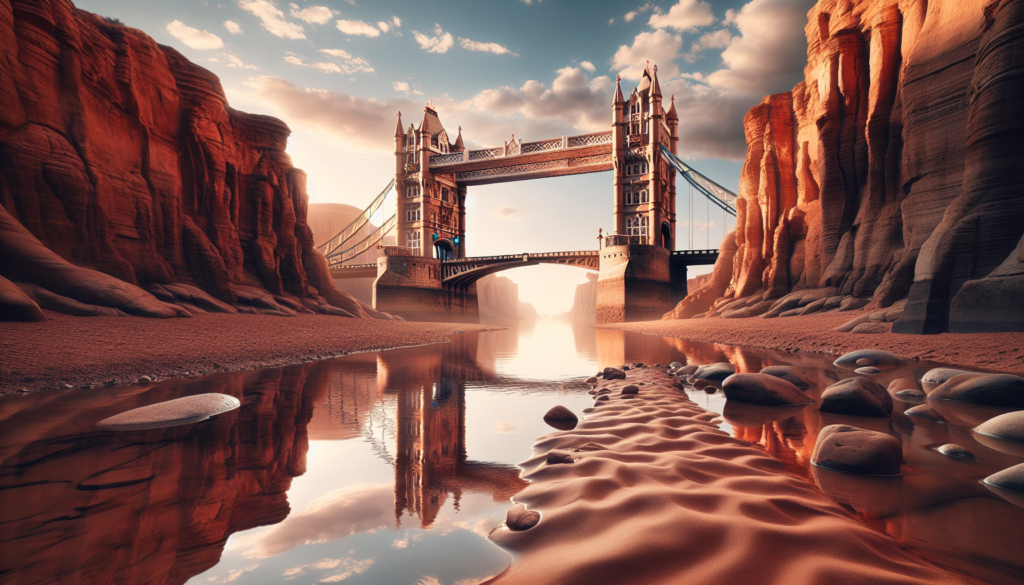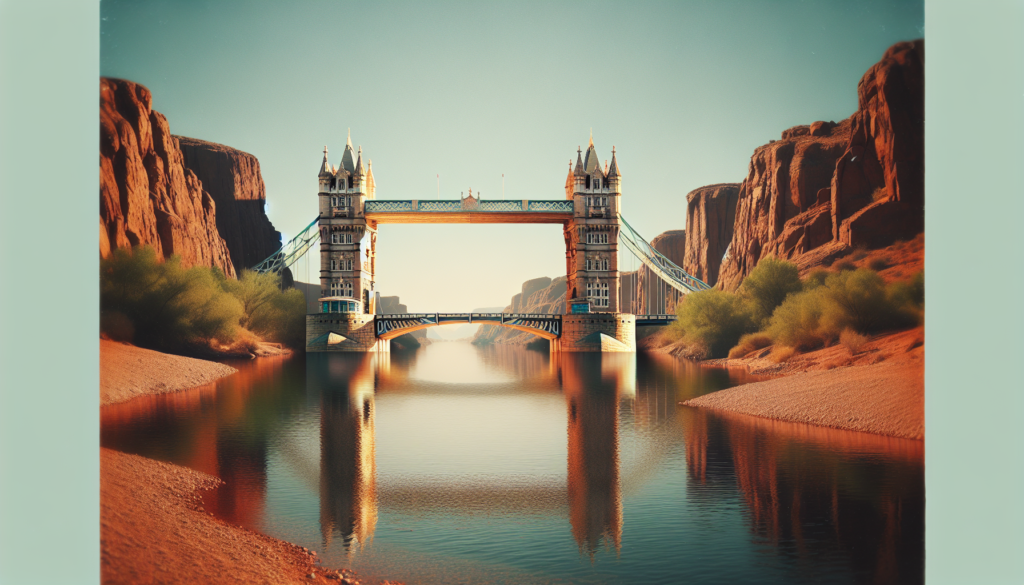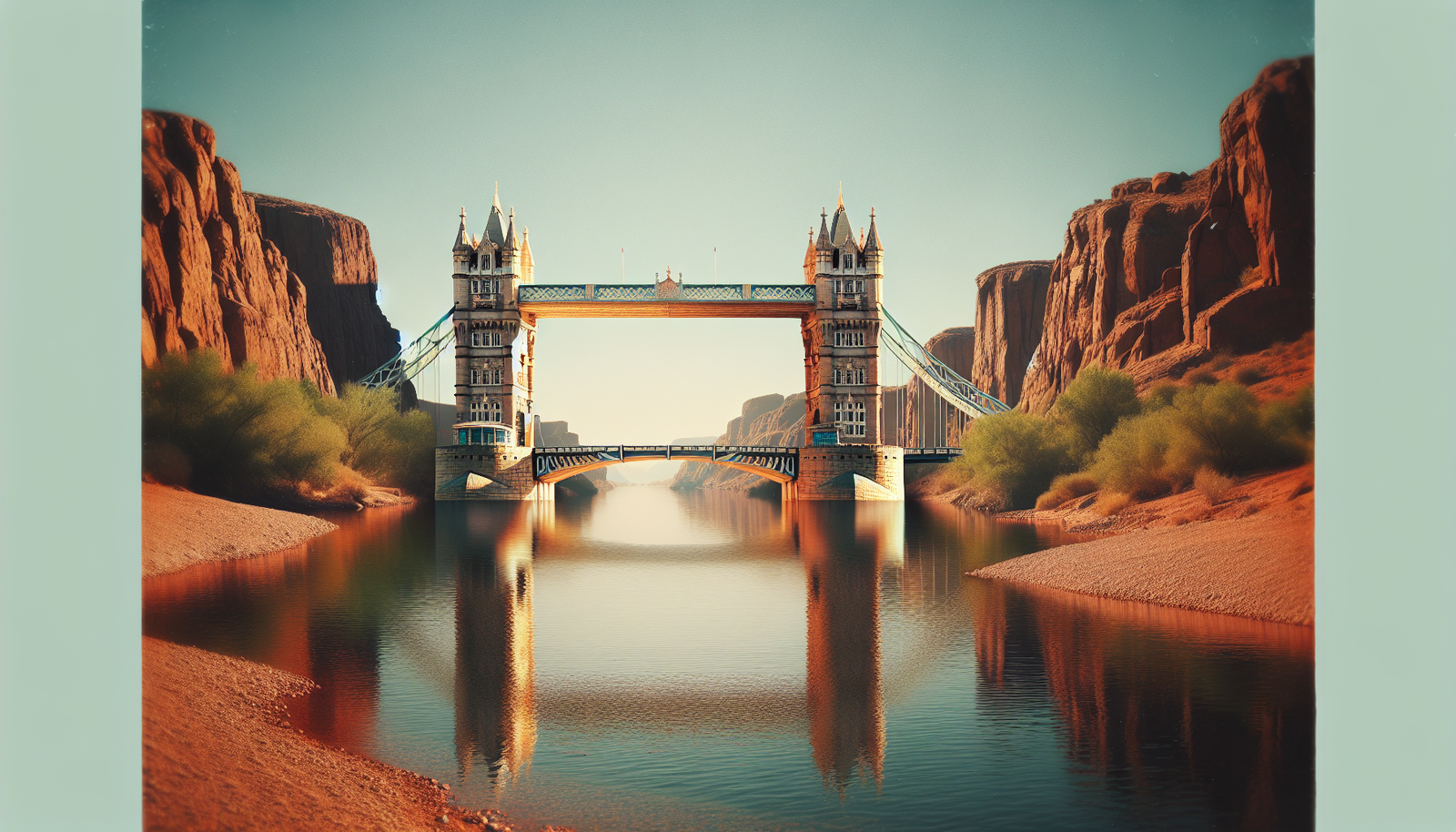As you unwrap the layers of history behind one of America’s more unusual sights, the fascinating tale of London Bridge in Lake Havasu City, Arizona, comes to light. Transplanted stone by stone from its original river-spanning spot in the heart of London, this iconic bridge found a new lease on life in the expansive deserts of Arizona. Join in the discovery of how this quintessential piece of English heritage crossed the Atlantic to become a cherished piece of the American landscape and a true Arizona landmark.

Origins of London Bridge
Historical significance of the original London Bridge
Imagine yourself standing in the midst of ancient London, where the first London Bridge spanned the River Thames. Its origins date back to Roman times when the first iteration was likely a wooden ponton bridge. Over the centuries, the bridge saw many reconstructions, with the medieval stone version being a central fixture in the city’s history. The original London Bridge not only served as a crucial crossing point but also held a strategic position during many significant historical events in England, including battles and uprisings. Its existence played a pivotal role in the development of London, both as a city and as an economic powerhouse.
Architectural features of the bridge in London
The architectural majesty of the original bridge is something to marvel at. It was completed in the early 13th century and featured multiple arches, a drawbridge, defensive gatehouses, and even buildings that stood atop it. Merchants and residents lived in the structures built upon the bridge, turning it into a bustling thoroughfare. Up to 200 buildings once adorned the bridge, creating a somewhat chaotic but vibrant environment. As London’s population grew, so did the importance of this structure.
The bridge’s role in London’s transportation history
In terms of transportation, your forefathers’ version of commuting would have been vastly different due to the role of this bridge. For over 600 years, until 1750, it was the only bridge crossing the Thames in London, making it a vital corridor for trade and travel between the north and south of the city. It withstood various disasters, such as the Great Fire of London, and became one of the city’s most iconic landmarks.
The Sale of London Bridge
Reasons behind the selling of the bridge
By the 20th century, the bridge was no longer fit for purpose. After years of braving London’s ever-increasing traffic, the bridge began to sink – an inch every eight years, to be exact. Due to its deterioration and the need for a wider and more modern structure to accommodate vehicles, the decision was made to replace and sell the historic bridge.
Who sold the bridge and to whom
Your bridge – a staple of classic London – was sold in 1968. The City of London sold it to Robert P. McCulloch, an American entrepreneur, and the founder of Lake Havasu City, Arizona. Ivan Luckin, a member of the Common Council of the City of London, was instrumental in conceiving and facilitating the sale. It was an audacious move that captured the world’s attention.
Public reaction to the sale in the UK
Public reaction in the United Kingdom was mixed. While some saw it as an enterprising way to preserve a piece of history, others felt a pang of loss that such an iconic piece of the city’s heritage was being shipped overseas. The sale was a unique and historic event, stirring debates and conversations for years to come.
London Bridge’s Transatlantic Journey
Dismantling process in London
The dismantling process was an engineering spectacle. Each stone was meticulously numbered before being taken down, ensuring that you could later rebuild it exactly as it stood in London. The task required precision and care to preserve the integrity of each piece of the bridge.
Transportation and challenges
The transportation of the bridge presented numerous challenges. The stones – all 10,000 tons of them – embarked on a transatlantic journey, first taking a voyage by ship across the ocean and then by truck through the winding roads of the American Southwest to reach their final destination in Arizona. This logistical endeavor was a testament to the boldness of the project.
Reconstruction process in Arizona
Once the stones arrived, the reconstruction process began. It was akin to assembling a giant jigsaw puzzle. You had the advantage of modern engineering and construction techniques to rebuild the bridge over a dredged section of the Colorado River, giving the appearance of the original waterway beneath it in London.
Robert P. McCulloch’s Vision
Who was Robert P. McCulloch?
Robert P. McCulloch was more than just an entrepreneur; he was a visionary. He saw potential in the vastness of the Arizona desert and was the founder of Lake Havasu City. By securing the purchase of London Bridge, McCulloch aimed to put this new city on the map.
How McCulloch’s vision shaped Lake Havasu City
McCulloch’s vision transformed Lake Havasu City from a sleepy town into a buzzing hub of activity. The bridge was intended to serve as a catalyst for development, attracting residents, businesses, and tourists. This grand gesture signaled the ambitious spirit of the community and its founder.
The bridge as a cultural and commercial boon
True to McCulloch’s vision, London Bridge became an iconic landmark in the area, drawing visitors from far and wide. It contributed to the cultural identity of Lake Havasu City and played a significant role in its economic growth. The bridge started as a historical edifice but soon became a place where events, commerce, and community life flourished.

Resurrecting London Bridge in Arizona
Engineering and architectural efforts
The resurrection of the bridge required the prowess of skilled engineers and architects. They not only had to ensure its historical accuracy but also adapt it to the new environment. Reinforced concrete supports were crafted to hold the original facade, blending the old with the new in a seamless manner.
Differences between the London and Arizona structures
You can spot some differences between the original bridge in London and the one that stands in Arizona. For example, in Arizona, the bridge is longer due to the redesigned canal it spans, and the reconstructed bridge features a walkway for tourists to enjoy panoramic views, a feature the medieval structure lacked.
Inauguration of the bridge and early reactions
The inauguration of the bridge in 1971 was met with a mix of amazement and curiosity. Initially, some skeptics viewed the project with disbelief, but most early reactions were positive, and people quickly embraced the bridge as a proud symbol of their city’s inventiveness and ambition.
An Arizona Landmark
Impact on Lake Havasu City’s development
The establishment of London Bridge as a centerpiece in Lake Havasu City accelerated the region’s development. Real estate values surged, and a commercial district sprouted nearby, changing the cityscape dramatically. The bridge’s presence has been integral to the city’s economic and social trajectory.
Tourism and the bridge
Tourism flourished with London Bridge as the main draw. Visitors come to marvel at the bridge’s historical significance, enjoy boat tours, and partake in waterfront activities. It has become an enduring attraction that continues to ignite the curiosity of those who hear its unique story.
Local cultural events and London Bridge
The bridge also serves as a gathering place for local cultural events. Parades, festivals, and ceremonies often take place against the backdrop of this historical monument, creating a tradition of community celebrations that cement the bridge’s place in the heart of Lake Havasu City.
Conservation and Maintenance
Challenges in desert climate
The conservation of London Bridge in a desert climate presents unique challenges. The arid conditions, extreme temperatures, and occasional flash floods require vigilant maintenance to preserve the structural integrity and appearance of the bridge.
Restoration efforts over the years
To tackle these challenges, restoration efforts have been ongoing since the bridge’s arrival. Periodic inspections, stone cleaning, joint repairs, and protective coatings are among the measures taken to ensure its continued presence as a historical treasure in the desert landscape.
Role of the city and local community
The city and its residents take great pride in their stewardship of the bridge. Both governmental and community support has been pivotal in conservation initiatives, ensuring that this symbol of determination and creativity endures for generations to come.
Unique Aspects of Lake Havasu’s London Bridge
Comparison to other relocated historical structures
London Bridge in Lake Havasu City sets itself apart when compared with other relocated historical structures. It’s not often that such a significant and large-scale monument is moved halfway across the world and reassembled, which speaks to the uniqueness of both the vision behind it and the community that embraced it.
The integration of the bridge with modern structures
Integrated with modern walkways, plazas, and landscaping, the bridge effortlessly merges with the surrounding infrastructure of the city, creating a harmonious balance between the historical and the contemporary.
Myths and legends associated with the bridge
Legends have followed London Bridge across the sea. There’s the mistaken belief that McCulloch thought he was buying the more ornate Tower Bridge, and tales of ghostly sightings from its London days that have added to the mythos surrounding the bridge, deepening its allure.
Public and Critical Reception
The bridge’s reception by Americans
In America, the response to London Bridge has been generally favorable. Local residents and visitors alike take pride in having a slice of international history in their backyard. The bridge has been welcomed as a novel piece of heritage, with its story adding to the rich tapestry of American cultural diversity.
Recognition by historical and cultural societies
Over time, historical and cultural societies have given the bridge due recognition for its architectural merits and significance as a transplanted cultural landmark. It’s a testament to how well the bridge has been integrated into its new setting while still retaining its storied past.
Depiction in media and popular culture
In media and popular culture, London Bridge has achieved celebrity status. It has featured in documentaries, travel shows, and has been used as a backdrop in various forms of entertainment, perpetuating its image as a well-traveled monument with a captivating narrative.
The Future of London Bridge in Arizona
Ongoing development plans around the bridge
Looking forward, development plans in the vicinity of the bridge are expected to continue to enhance its surroundings and accessibility. This includes further waterfront development, tourism facilities, and cultural venues that celebrate the bridge’s role in Lake Havasu City’s community.
Preservation efforts for future generations
Preservation efforts remain ongoing to ensure future generations can enjoy and learn from London Bridge. This encompasses educational programs, partnerships with preservation organizations, and the commitment of local authorities to maintain this historical edifice.
Potential changes and adaptations
As times change, so might the needs and representations of London Bridge in its Arizonian context. Adaptations to its surrounding area, technological enhancements for conservation, and creative uses of the space are all possibilities that await. Whatever the future holds, one thing is clear – the story of London Bridge in Lake Havasu City remains a fascinating chapter in the annals of history, a tale of transformation and the enduring spirit of human ingenuity.

